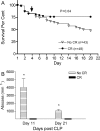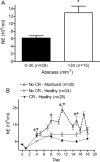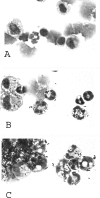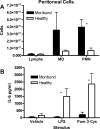Mechanisms of mortality in early and late sepsis
- PMID: 16926416
- PMCID: PMC1594860
- DOI: 10.1128/IAI.01220-05
Mechanisms of mortality in early and late sepsis
Abstract
A recent hypothesis postulates that sepsis moves through different phases, with periods of enhanced inflammation alternating with periods of immune suppression. In this study we determined the levels of inflammation present during early and late septic deaths to examine whether death was due to hyperinflammation or immunosuppression. The murine model of sepsis induced by cecal ligation and puncture (CLP) was used. Complete blood counts, plasma interleukin-6 (IL-6) levels, and body weights were determined. Mice that died within the first 4 days had increased plasma levels of IL-6, indicating that there was activation of the immune system. Cecal resection on day 4 after CLP resulted in decreased abscess size, lower circulating neutrophil counts, decreased anemia, and improved survival compared to the results for mice that received only antibiotic and fluid therapy. All of the mice that died in the chronic phase of infection (after day 4) had positive peritoneal cultures containing significantly more bacteria than the cultures for surviving mice. After day 4, none of the surviving mice exhibited increases in the plasma levels of IL-6. Dying mice exhibited mixed IL-6 responses; for 41% of the mice there was never an increase in the IL-6 levels in the chronic phase, while for other mice the levels of IL-6 transiently increased prior to death. Peritoneal macrophages were obtained in the late phase of sepsis from moribund and healthy mice and were stimulated ex vivo. The cells from the moribund mice produced significantly less IL-6 than the cells obtained from healthy mice produced. These results indicate that in mice that die in the early phase there is uniformly increased inflammation. However, during the chronic phase of sepsis, some mice die with evidence of immunosuppression (increased bacterial growth and low IL-6 levels), while other mice die with immunostimulation (high IL-6 levels and bacterial growth). Determining the inflammatory status of individual patients may help guide appropriate, targeted therapy.
Figures








References
-
- Andersen, B. R., F. L. Kallehave, and H. K. Andersen. 2003. Antibiotics versus placebo for prevention of postoperative infection after appendicectomy. Cochrane Database Syst. Rev. 2:CD001439. [Online.] - PubMed
-
- Angus, D. C., W. T. Linde-Zwirble, J. Lidicker, G. Clermont, J. Carcillo, and M. R. Pinsky. 2001. Epidemiology of severe sepsis in the United States: analysis of incidence, outcome, and associated costs of care. Crit. Care Med. 29:1303-1310. - PubMed
-
- Annane, D., V. Sebille, C. Charpentier, P. E. Bollaert, B. Francois, J. M. Korach, G. Capellier, Y. Cohen, E. Azoulay, G. Troche, P. Chaumet-Riffaut, and E. Bellissant. 2002. Effect of treatment with low doses of hydrocortisone and fludrocortisone on mortality in patients with septic shock. JAMA 288:862-871. - PubMed
-
- Ayala, A., and I. H. Chaudry. 1996. Immune dysfunction in murine polymicrobial sepsis: mediators, macrophages, lymphocytes and apoptosis. Shock 6(Suppl. 1):S27-S38. - PubMed
-
- Baker, C. C., I. H. Chaudry, H. O. Gaines, and A. E. Baue. 1983. Evaluation of factors affecting mortality rate after sepsis in a murine cecal ligation and puncture model. Surgery 94:331-335. - PubMed
Publication types
MeSH terms
Substances
Grants and funding
LinkOut - more resources
Full Text Sources
Medical
Miscellaneous

